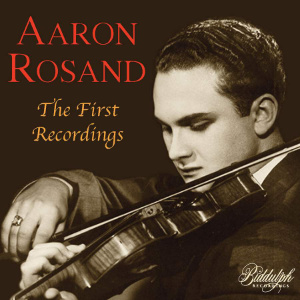
Aaron Rosand (violin)
The First Recordings
Johannes Brahms (1833-1897)
Sonata No. 1 in G major for Violin and Piano, Op. 78 (1879)
Sonata No. 2 in A major for Violin and Piano, Op. 100 (1886)
Ludwig van Beethoven (1770-1827)
Rondo in G major WoO 41 (1793-94)
12 Variations in F major Se vuol ballare (Mozart) WoO 40 (1794)
6 German Dances, WoO 42 (1796)
Eileen Flissler (piano)
rec. 1956 (Brahms), 1961 (Beethoven), location not noted
BIDDULPH 85021-2 [68]
Amongst Aaron Rosand’s earliest recordings was the set of Beethoven’s sonatas, made with his wife Eileen Flissler, for Vox. However, it didn’t represent his very earliest recordings for the company, which is what Biddulph has now transferred; the Brahms sonatas on PL10.090 and the small Beethoven pieces on SVBX-518F.
Rosand was not quite 30 when he recorded the first and second sonatas in mono in a characteristically boxy Vox mono acoustic. Yet the violin sound is forwardly placed and is itself well balanced with Flissler’s piano. Rosand’s gleaming tonal resources are spearheaded by a wonderfully singing tone and he takes well-nigh perfect tempi throughout. His lyricism is both vivid and stylistically apt, his lower strings nutty-brown, the upper always retaining body and weight. In many ways, and on admittedly limited recorded evidence, Rosand surpassed his erstwhile teacher Efrem Zimbalist as a Brahms player. The central movement of the Sonata in G shows the full range and breadth of Rosand’s tone colours, rich ochre double stops included, and the sensitive shaping of the line is only enhanced by the insightful playing and rock-solid ensemble generated by Flissler.
Eloquence is a Rosand watchword, but it’s expressively committed eloquence as the Sonata in A reveals, where Rosand, his scale perfectly equalized, proves a formidably generous performer. The balance of the second movement is splendidly realized, its playfulness – the pizzicati are just right – balanced by its extrovert vitality. So too in the finale where his warm intensity is full-blooded but always controlled by fine taste.
Rosand and Flissler must have been among the first, if not the very first, to have recorded all Beethoven’s music for violin and piano and for the second Vox restoration, a stereo LP released in 1961, they turn to Beethoven’s youthful, sometimes playful side. Who else at the time was delving back to record the Se vuol ballare variations from The Marriage of Figaro? At eleven minutes it allows Beethoven full rein and the Rosand-Flissler team savour its witty moments. Flissler digs into her solo variation with real aplomb. The Rondo in G is charmingly done, and nothing is over-pressed even whilst it is full of vibrant tone and excellent rhythm. The six dances, little generic morceau pieces, are similarly excellent.
The LPs from which these transfers have been made sound very clean and without audible blemish. Wayne Kiley’s notes run through salient features well and this Biddulph disc treats Rosand’s recorded legacy with the respect it assuredly deserves.
Jonathan Woolf
Help us financially by purchasing from




















